The ASRock Z170 Extreme7+ Review: When You Need Triple M.2 x4 in RAID
by Ian Cutress on November 27, 2015 11:59 AM EST- Posted in
- Motherboards
- ASRock
- M.2
- Skylake
- Z170
System Performance
Not all motherboards are created equal. On the face of it, they should all perform the same and differ only in the functionality they provide - however this is not the case. The obvious pointers are power consumption, but also the ability for the manufacturer to optimize USB speed, audio quality (based on audio codec), POST time and latency. This can come down to manufacturing process and prowess, so these are tested.
Power Consumption
Power consumption was tested on the system while in a single MSI GTX 770 Lightning GPU configuration with a wall meter connected to the OCZ 1250W power supply. This power supply is Gold rated, and as I am in the UK on a 230-240 V supply, leads to ~75% efficiency > 50W, and 90%+ efficiency at 250W, suitable for both idle and multi-GPU loading. This method of power reading allows us to compare the power management of the UEFI and the board to supply components with power under load, and includes typical PSU losses due to efficiency. These are the real world values that consumers may expect from a typical system (minus the monitor) using this motherboard.
While this method for power measurement may not be ideal, and you feel these numbers are not representative due to the high wattage power supply being used (we use the same PSU to remain consistent over a series of reviews, and the fact that some boards on our test bed get tested with three or four high powered GPUs), the important point to take away is the relationship between the numbers. These boards are all under the same conditions, and thus the differences between them should be easy to spot.

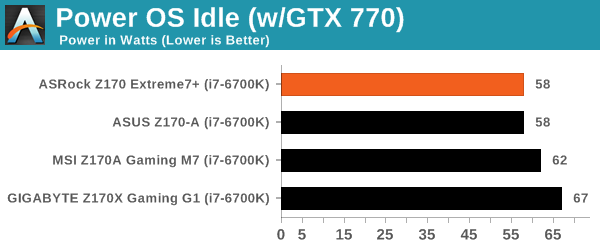
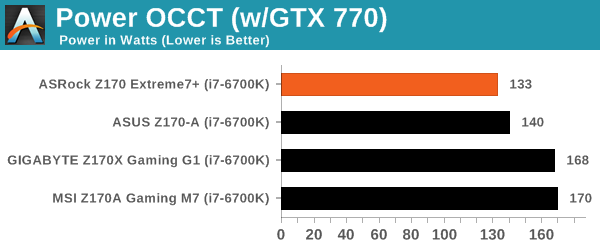
While the ASRock was not strictly the lowest consumer of power at idle, when we look at the idle to load differential, it shows a 73W gain for the i7-6700K, compared to the 110W seen on the MSI. This is in part because we saw a number of the early motherboard BIOSes overestimate the load voltage required at stock, as well as an element of MultiCore Turbo keeping voltages high. But in this case, because the ASRock does not have multicore turbo, it saves power at the wall.
Non UEFI POST Time
Different motherboards have different POST sequences before an operating system is initialized. A lot of this is dependent on the board itself, and POST boot time is determined by the controllers on board (and the sequence of how those extras are organized). As part of our testing, we look at the POST Boot Time using a stopwatch. This is the time from pressing the ON button on the computer to when Windows 7 starts loading. (We discount Windows loading as it is highly variable given Windows specific features.)
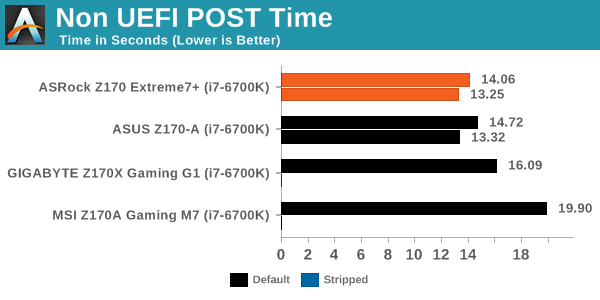
Because this is still early days for the Z170 platform, POST times are seemingly all over the place as motherboard manufacturers optimize their boot routines. Nevertheless, the ASRock comes out on top in its default setting, over the ASUS, GIGABYTE and way ahead of the MSI.
Rightmark Audio Analyzer 6.2.5
Rightmark:AA indicates how well the sound system is built and isolated from electrical interference (either internally or externally). For this test we connect the Line Out to the Line In using a short six inch 3.5mm to 3.5mm high-quality jack, turn the OS speaker volume to 100%, and run the Rightmark default test suite at 192 kHz, 24-bit. The OS is tuned to 192 kHz/24-bit input and output, and the Line-In volume is adjusted until we have the best RMAA value in the mini-pretest. We look specifically at the Dynamic Range of the audio codec used on board, as well as the Total Harmonic Distortion + Noise.

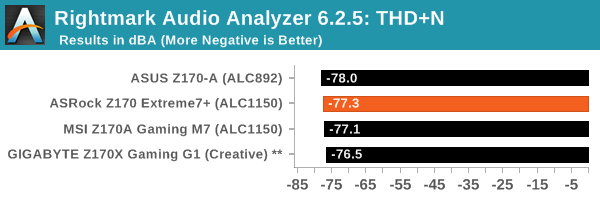
Using the ALC1150 and an improved design should put the ASRock implementation near the top for audio, and the -103 dBA result for SNR shows it.
USB Backup
For this benchmark, we transfer a set size of files from the SSD to the USB drive using DiskBench, which monitors the time taken to transfer. The files transferred are a 1.52 GB set of 2867 files across 320 folders – 95% of these files are small typical website files, and the rest (90% of the size) are small 30 second HD videos. In an update to pre-Z87 testing, we also run MaxCPU to load up one of the threads during the test which improves general performance up to 15% by causing all the internal pathways to run at full speed.
Due to the introduction of USB 3.1, as of June 2015 we are adjusting our test to use a dual mSATA USB 3.1 Type-C device which should be capable of saturating both USB 3.0 and USB 3.1 connections. We still use the same data set as before, but now use the new device. Results are shown as seconds taken to complete the data transfer.
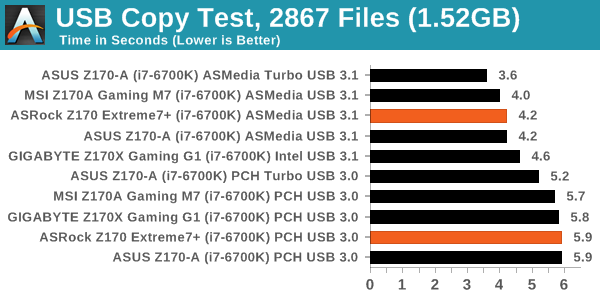
Like most of the USB 3.1 enabled motherboards on launch day, the ASMedia controller for the USB ports performs well although there does seem to see some variation in results as this is also optimized in firmware and drivers.
DPC Latency
Deferred Procedure Call latency is a way in which Windows handles interrupt servicing. In order to wait for a processor to acknowledge the request, the system will queue all interrupt requests by priority. Critical interrupts will be handled as soon as possible, whereas lesser priority requests such as audio will be further down the line. If the audio device requires data, it will have to wait until the request is processed before the buffer is filled.
If the device drivers of higher priority components in a system are poorly implemented, this can cause delays in request scheduling and process time. This can lead to an empty audio buffer and characteristic audible pauses, pops and clicks. The DPC latency checker measures how much time is taken processing DPCs from driver invocation. The lower the value will result in better audio transfer at smaller buffer sizes. Results are measured in microseconds.

For whatever reason, our DPC result came back rather poorly here. We’re not sure if it’s just a BIOS not set up for DPC Latency, or something more fundamental. As time goes on and the platform matures, we’ll see more motherboards underneath 100.










63 Comments
View All Comments
phorgan1 - Tuesday, December 22, 2015 - link
And it is 3.93 GB/s for 4 lanes of DMI 3.0nunya112 - Friday, November 27, 2015 - link
no. they will have their own. if there is no video card installed or if they only set the video card to 4Xthat would then dedicate all the lanes
4 will be in the DMI links, then depending if they have video card or not there will be 12 lanes free. meaning it would go full speed at 4X EACH = 12 lanes then the 4 lanes for the video card. or even none if using onboard
phoenix_rizzen - Sunday, November 29, 2015 - link
The video card slots get their lanes direct from the CPU.The M.2 slots get their lanes from the PCH, along with the x1 and x4 slots.
Separate lanes; not shared.
You can run SLI video setup using 16 lanes from the CPU, and still use 12 lanes for M.2.
extide - Monday, November 30, 2015 - link
BUT evilspoons/eddieobscurant are correct. The DMI link is EQUIVALENT to a PCIe 3.0 x4 link. Regardless of the video card setup, the 3 M.2 ports are sharing essentially the B/W of a single PCIe 3.0 x4 link.WITH THAT BEING SAID, this is still my #1 Z170 mobo. The feature combo is PERFECT. DO WANT
phoenix_rizzen - Monday, November 30, 2015 - link
Only if the storage controller is on the CPU, no? The DMI link is between the CPU and the PCH, correct? And the storage controller won't be sending all storage traffic through to the CPU (this isn't IDE), so that shouldn't be a bottleneck.extide - Thursday, December 3, 2015 - link
Where else is the data going to go? I mean if you are copying from one drive to another that are both hanging off the PCH ... I am not sure if it needs to go through the CPU or if it has something like DMA.Ian Cutress - Friday, November 27, 2015 - link
Something seems to have gone awry with our content engine. It should be fixed now.bug77 - Friday, November 27, 2015 - link
One of these babies should be delivered to my door tomorrow. Needless to say, I can't wait.Idrathernotsay - Friday, November 27, 2015 - link
Would it be possible to see a review of one of the lower-end z170 motherboards, even a quick test? I realize that they don't provide much in the way of interesting or remarkable features, but I'd be really interested in seeing what, if anything, you actually lose with a mobo under $100 in performance if you don't care enough about the "crazy" stuff to fork over twice or three times as much cash.Impulses - Friday, November 27, 2015 - link
Didn't they review the ASUS Z170-A? It's a little over your budget but it's one of the better "cover all bases" budget options (2 3.0 headers, Type C in back, M.2, etc). I think when you start going closer to $100 than $150 you do sacrifice a lot more than it's worth, starting with build quality.